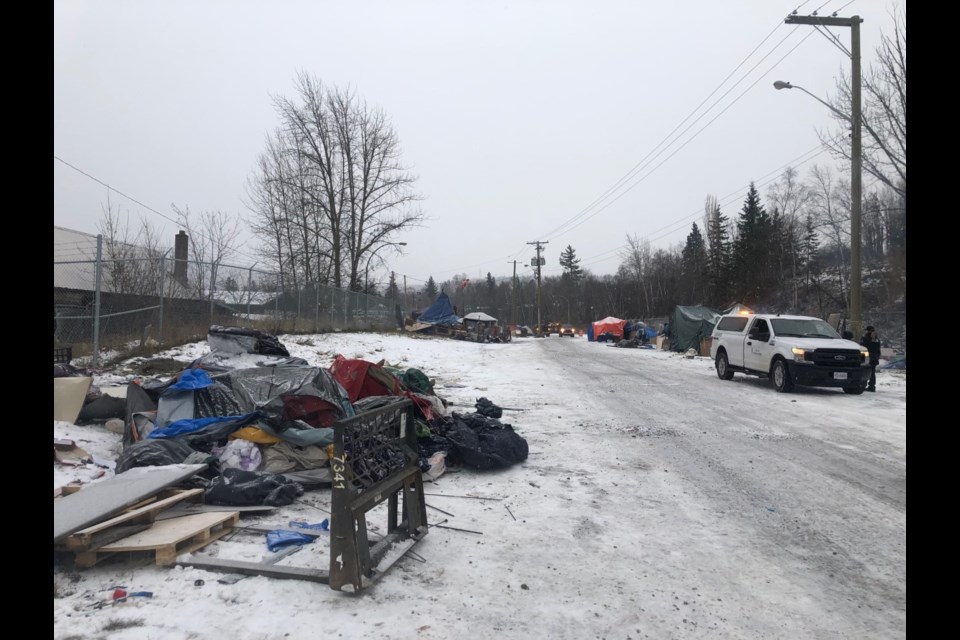Senior City of Prince George officials believed they were “well within our authority” to remove shelters and belongings from the Lower Patricia encampment, on Nov. 17, 2021, despite an existing court order, internal emails show.
However, in the days after Nov. 17, the tone of the emails circulating between City of Prince George staff changed about the actions taken at the encampment, named Moccasin Flats by residents.
“Apparently the professional protesters are becoming worked up today about all the equipment and BC Housing is wondering if we should back off because the optics are bad,” city communications manager Julie Rogers wrote in an email to city bylaw services manager Charlotte Peters on the morning of Nov. 18, 2021. “We are nearly done though aren’t we? I hope to get the news release out very shortly and will send it to you when it’s ready. We are trying to change the conversation to address safety.”
Emails obtained by The Citizen from BC Housing and the City of Prince George, through a Freedom of Information request, reveal what was happening behind the scenes at city hall on Nov. 17, 2021 and in the days that followed.
'OUR LEGAL COUNSEL HAVE BEEN CONSULTED THROUGHOUT'
On Nov. 17, 2021, just before 3 p.m., city director of public safety Adam Davey sent out an update to the mayor and city council, city staff, RCMP, BC Housing, the city’s legal counsel and others, about the city operation at the Lower Patricia encampment.
BC Housing had relocated 10 people voluntarily from the encampment to the former Knights Inn location and others, Davey wrote. City bylaw and parks staff were “acting in a support role” to BC Housing and AWAC, which provided the transportation.
“As of now, the majority of occupants have moved and most of the encampment is empty. There appears to be only two tent sites with remaining occupants (however, it appears some continue to loiter about),” Davey wrote. “Some ‘Together We Stand’ supporters and the defendant’s legal counsel arrived on scene and appeared to be upset about this housing opportunity provided by BC Housing. City staff moved offsite to minimize any potential friction.”
The city will continue to consult with BC Housing during the “large and ongoing” clean up of the site, he wrote.
“Our legal counsel have been consulted throughout BC Housing’s voluntary rehousing opportunity, and this does not appear to affect our ongoing legal Appeal Process,” Davey wrote. “Clean-up activities will resume when appropriate to do so.”
That "ongoing legal appeal process" involved an October 25, 2021 court order instructing the City of Prince George to leave the location intact until suitable housing and daytime facilities were in place.
Roughly 15 minutes after Davey’s update, Peters the bylaw services manager, sent her own email to city and BC Housing senior and frontline staff, thanking them for their work.
“I know it was a bit awkward when the representatives from Together We Stand arrived but I wanted to assure all of you that we were well within our authority to do what we were doing,” Peters wrote. “All of the property that was being removed was abandoned and was determined to be abandoned through consultation with the occupants of the various tents and structures. In relation to the Order that came out of the Supreme Court we were also in line with that as the people were being transitioned into housing and not just told to move elsewhere. I firmly believe that we are doing the best for the folks in the camp as well as for the people in Prince George. I appreciate all of your efforts.”
MAYOR, COMMITTEE WANTED ANSWERS
The City of Prince George’s communications department began receiving media inquires regarding the demolition starting on the morning of Nov. 17. Former mayor Lyn Hall was also getting questions from the city’s Select Committee on a Safe, Clean, and Inclusive Community, emails indicate.
First thing on the morning on Nov. 18, Babicz wrote an email to Hall, saying he’d instructed Rogers and the city’s communications team to prepare a response to the committee for him. Senior city staff were included in the email chain and were asked to provide input.
It was this discussion that prompted the comment from Rogers about “professional protesters” and the poor optics of using heavy machinery to clear out the structures, quoted earlier.
“The only sites that were ‘bulldozed’ were sites that had been left behind by those who transitioned into housing,” Peters responded. “The rationale was to get rid of fire hazards and try and get some of it clean before everything froze to the ground. Also important to point out that some folks are choosing to stay in the camp and the city has not disturbed those sites at all.”
City director of civic operations Blake McIntosh added the use of machinery was needed for efficiency.
“The sheer volume of the camp contents dissuades manual clean-up and the equipment provides a layer of safety for staff performing this work,” McIntosh wrote.
On Feb. 23, 2022, B.C. Supreme Court Justice Simon Coval ruled the city had violated the previous court order and had “inflicted serious harm on vulnerable people” in the process. In March, the City of Prince George ended its court appeals of the rulings and issued a formal apology for the actions taken on Nov. 17, 2021.
Part 3 of this three-part series will look at emails from the city’s frontline staff about how the operation proceeded on Nov. 17, 2021.





